|
ID
|
Thumbnail |
Media Data |
| 2693 |
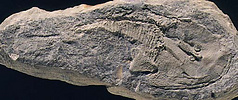
|
|
| 2925 |

|
|
Scientific Name
|
Sacabambaspis
|
|
Location
|
Bolivia
|
|
Comments
|
The best known arandaspid, Sacabambaspis, from the Ordovician of Bolivia, shows the characteristic, frontally positioned eyes, like car head lamps.
|
|
Reference
|
after Janvier, P. (1996). Early Vertebrates. Oxford Monographs in Geology and Geophysics, 33, Oxford University Press, Oxford.
|
|
Image Use
|
 This media file is licensed under the Creative Commons Attribution License - Version 3.0. This media file is licensed under the Creative Commons Attribution License - Version 3.0.
|
|
Copyright
|
© 1997

|
|
Attached to Group
|
Arandaspida: view page image collection
|
|
Title
|
arandaspida.gif
|
|
Image Type
|
Drawing/Painting
|
|
Image Content
|
Specimen(s)
|
|
ID
|
2925
|
|
| 3620 |
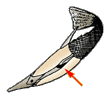
|
|
Body Part
|
Heterostracans are characterized by a single, common external opening on either side of the head armor (red arrow)
|
|
Image Use
|
 This media file is licensed under the Creative Commons Attribution License - Version 3.0. This media file is licensed under the Creative Commons Attribution License - Version 3.0.
|
|
Copyright
|
©

|
|
Attached to Group
|
Heterostraci: view page image collection
|
|
Title
|
opening.2.gif
|
|
Image Type
|
Drawing/Painting
|
|
Image Content
|
Specimen(s), Body Parts
|
|
ID
|
3620
|
|
| 3893 |
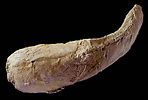
|
|
Scientific Name
|
Sacabambaspis janvieri
|
|
Location
|
Bolivia
|
|
Comments
|
almost complete specimen
|
|
Specimen Condition
|
Fossil -- Period: Ordovician (Caradoc)
|
|
Image Use
|
 This media file is licensed under the Creative Commons Attribution License - Version 3.0. This media file is licensed under the Creative Commons Attribution License - Version 3.0.
|
|
Copyright
|
©

|
|
Attached to Group
|
Sacabambaspis (Arandaspida): view page image collection
|
|
Title
|
sacabambaspis.jpeg
|
|
Image Type
|
Photograph
|
|
Image Content
|
Specimen(s)
|
|
ID
|
3893
|
|
| 3914 |

|
|
Location
|
Colorado
|
|
Comments
|
The overall morphology of eriptychiids is still unknown, despite the abundance of their dermal bone fragments bearing large, oval tubercles, in the Ordovician of Colorado.
|
|
Reference
|
from Ørvig, T. (1958). Pycnaspis splendens, new genus, new species, a new ostracoderm from the Upper Ordovician of North America. Proceedings of the United States National Museum, 108:1-23.
|
|
Body Part
|
dermal bone fragment
|
|
Copyright
|
© Smithsonian Institution Press
|
|
Image Use
|
restricted
|
|
Attached to Group
|
Eriptychiida: view page image collection
|
|
Title
|
eriptychiida.gif
|
|
Image Type
|
Drawing/Painting
|
|
Image Content
|
Body Parts
|
|
ID
|
3914
|
|
| 4380 |

|
|
Location
|
Australia
|
|
Comments
|
Pituriaspids are mainly known by Pituriaspis, from the Devonian of Australia. As a whole, their headshield is quite similar to that of osteostracans, though devoid of a naso-hypophysial opening. The mouth, gill openings and presumably the nasal aperture were all situated on the ventral side of the head. Well-developed paired fins attached on either sides of the headshield. The only diagnostic feature of pituriaspids is an enigmatic pit adjacent to the eyes.
|
|
Reference
|
based on Young, G. C. (1991). The first armoured agnathan vertebrates from the Devonian of Australia. In Early vertebrates and related problems of evolutionary biology (ed. M. M. Chang, Y. H. Liu, and G. R. Zhang), pp. 67-85. Science Press, Beijing.
|
|
Specimen Condition
|
Fossil -- Period: Devonian
|
|
Image Use
|
 This media file is licensed under the Creative Commons Attribution License - Version 3.0. This media file is licensed under the Creative Commons Attribution License - Version 3.0.
|
|
Copyright
|
© 1997

|
|
Attached to Group
|
Pituriaspis (Pituriaspida): view page image collection
|
|
Title
|
pituriaspida.gif
|
|
Image Type
|
Drawing/Painting
|
|
Image Content
|
Specimen(s)
|
|
ID
|
4380
|
|
| 4467 |
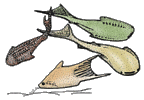
|
|
Scientific Name
|
Lanarkia, Loganellia
|
|
Comments
|
Thelodonts are a still poorly known group of Silurian and Devonian jawless vertebrates, whose dermal skeleton consists of minute scales. Most thelodonts have a dorsoventrally depressed body and head, the gill openings being situated on the ventral side. It is assumed that the snout was more or less as in primitive galeaspids; that is, with a broad, inhalent median opening and a slightly ventral mouth. Among the flat-bodied forms are Lanarkia (top left), provided with long, spine-shaped scales, and Loganellia (top right and middle). Other thelodonts, such as an unnamed form from the Devonian of Canada (bottom) are deep-bodied, with lateral gill openings and a very large, forked tail.
|
|
Reference
|
Based on Turner, S. 1991. Monophyly and interrelationships of the Thelodonti.In Early vertebrates and related problems of evolutionary biology (ed. M. M. Chang, Y. H. Liu, and G. R. Zhang), pp. 87-119. Science Press, Beijing. AND Turner, S. 1992. Thelodont lifestyles. In Fossil fishes as living animals (ed. E. Mark-Kurik), Akademia, 1:21-40. AND Wilson & Cadwell 1993
|
|
Specimen Condition
|
Fossil
|
|
Image Use
|
 This media file is licensed under the Creative Commons Attribution License - Version 3.0. This media file is licensed under the Creative Commons Attribution License - Version 3.0.
|
|
Copyright
|
© 1997

|
|
Attached to Group
|
Thelodonti: view page image collection
|
|
Title
|
thelodonti.gif
|
|
Image Type
|
Drawing/Painting
|
|
Image Content
|
Specimen(s)
|
|
ID
|
4467
|
|
| 4676 |
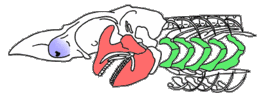
|
|
Comments
|
The skull of a gnathostome, or jawed vertebrates (here a shark), are characterized by vertically biting jaws (red) consisting of the palatoquadrate dorsally and the Meckelian cartilage ventrally. The gill arches (green) are situated internally to the gill filaments, and the nasal capsules (blue) open to the exterior by means of paired nostrils.
|
|
Acknowledgements
|
after Janvier, P. (1996). Early Vertebrates. Oxford Monographs in Geology and Geophysics, 33, Oxford University Press, Oxford.
|
|
Body Part
|
skull
|
|
Image Use
|
 This media file is licensed under the Creative Commons Attribution License - Version 3.0. This media file is licensed under the Creative Commons Attribution License - Version 3.0.
|
|
Copyright
|
© 1997

|
|
Attached to Group
|
Chondrichthyes (Gnathostomata): view page image collection
|
|
Title
|
gnathostomata.gif
|
|
Image Type
|
Drawing/Painting
|
|
Image Content
|
Body Parts
|
|
ID
|
4676
|
|
| 4715 |

|
|
Comments
|
Pteraspidomorphs are among the earliest known vertebrates. They were jawless and possessed a massive dermal skeleton. They are characterized by their dermal head armor having large, median, ventral and dorsal plates or "shields" (red).
|
|
Reference
|
after Janvier 1996
|
|
Specimen Condition
|
Fossil
|
|
Image Use
|
 This media file is licensed under the Creative Commons Attribution License - Version 3.0. This media file is licensed under the Creative Commons Attribution License - Version 3.0.
|
|
Copyright
|
© 1997

|
|
Attached to Group
|
Pteraspida: view page image collection
|
|
Title
|
pteraspidomorphi.gif
|
|
Image Type
|
Drawing/Painting
|
|
Image Content
|
Specimen(s)
|
|
ID
|
4715
|
|
| 4891 |

|
|
Scientific Name
|
Hyperoartia, Mayomyzon
|
|
Location
|
Illinois
|
|
Comments
|
Some modern lampreys (top) are external parasites of other fishes and suck their blood by attaching to their prey by means of a large sucker surrounding their mouth. Lampreys have a single, median and dorsal "nostril", the nasohypophysial opening, which is situated anteriorly to the eyes. One of the earliest known fossil lamprey, Mayomyzon (bottom), from the Late Carboniferous of Illinois, may not have been such a parasitic form and had a stouter body than modern lampreys).
|
|
Reference
|
Bardack, D. and Zangerl, R. (1971). Lampreys in the fossil record. In The Biology of lampreys (ed. M. W. Hardisty and I. C. Potter), Vol. 1, pp. 67-84. Academic Press, London.
|
|
Acknowledgements
|
after Bardack, D. and Zangerl, R. (1971). Lampreys in the fossil record. In The Biology of lampreys (ed. M. W. Hardisty and I. C. Potter), Vol. 1, pp. 67-84. Academic Press, London.
|
|
Specimen Condition
|
Fossil -- Period: Late Carboniferous
|
|
Image Use
|
 This media file is licensed under the Creative Commons Attribution License - Version 3.0. This media file is licensed under the Creative Commons Attribution License - Version 3.0.
|
|
Copyright
|
© 1997

|
|
Attached to Group
|
old Hyperoartia: view page image collection
|
|
Title
|
hyperoartia.gif
|
|
Image Type
|
Drawing/Painting
|
|
Image Content
|
Specimen(s)
|
|
ID
|
4891
|
|










 This media file is licensed under the
This media file is licensed under the 
 Go to quick links
Go to quick search
Go to navigation for this section of the ToL site
Go to detailed links for the ToL site
Go to quick links
Go to quick search
Go to navigation for this section of the ToL site
Go to detailed links for the ToL site